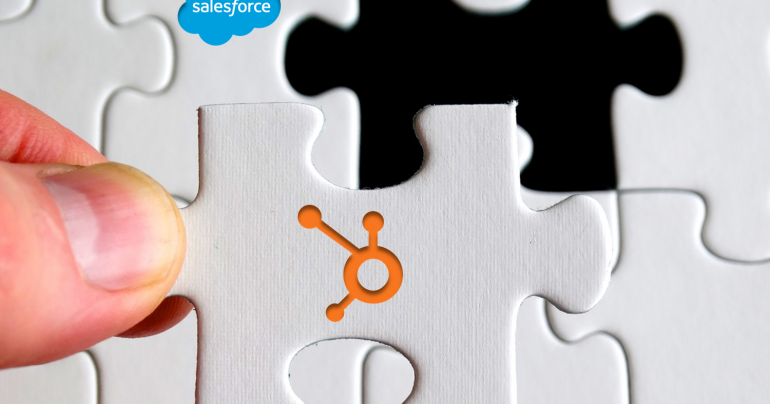Hubspot Salesforce Integration Best Practices: Before, During and After

If you haven't set up you Salesforce and Hubspot integration previously, you are probably going to make some very costly mistakes. We have seen it many times.
But don't fret. In this article, we have gathered the most important considerations you should make before, during and after the integration.
Read it carefully, and you will ultimately save a lot of time, and have a cleaner working, better integration.
Step 1: Before integrating Hubspot and Salesforce
Security Token: Find your Salesforce Security Token. Think about whether the person who created it should be the person who owns Hubspot-created leads and contacts in Salesforce. Otherwise let another person reset it (be careful if you use that security token for other Salesforce syncs).
Sync list: Which leads should sync from Hubspot to Salesforce? Create an inclusion list. It can be empty in the beginning.
Sync only new HS contacts: If you have been using HS for a long time, you may not want all of them to create SF leads/contacts. You may want to sync only new ones. In that case, create a date criteria in your inclusion list.
How many contacts do you have in SF?: If you have a lot, this may increase your HS pricing. You may want to delete old/irrelevant leads and contacts before syncing.
How many API calls do you have in SF?: Check the number of API calls available in your SF account. The number of contacts you are importing multiplied by 3 should be lower than this limit. Otherwise it will pause importing and resume the next day when your limit is refreshed. You can call Salesforce support and ask them to temporarily increase your limit.
Turn on state and country picklists in SF: Salesforce used to have states and countries as free text fields, but you now have the option to have them as picklists. We recommend that before you start your HS-SF sync, start the state and country picklist options in SF. Your SF administrator can turn this setting on by following these instructions: https://help.salesforce.com/HTViewHelpDoc?id=admin_state_country_picklists_overview.htm&language=en_US
2: During your integration of Hubspot and Salesforce
Entering the security token correctly: When entering the SF security token in HS, do not put the password in front of the token. (HS will do this automatically in the backend when sending to SF.)
Account and Opportunity sync: It is recommended that you turn Account Sync and Opportunity Sync on during the configuration so that you get account information as well as contact/lead information.
Importing: Once you’ve finished setting the sync up, you will be asked if you want to import existing contacts. We recommend not doing so in the beginning since you may want to have time to test running the sync in production for a while without importing all contacts. This means only contacts updated in SF after the sync has been set up will be imported into HS.
3: After you have integrated Hubspot and Salesforce
View HS info in SF: Put the Hubspot Intelligence sections in your Leads and Contacts views.
Include contacts created by SF in your sync list: If you have an inclusion list in HS, this means only contacts in that inclusion list will sync to SF. But a contact created in SF will sync to HS. This means, if a contact is created is synced from SF to HS, but is not in HS inclusion list, changes in HS will not sync back to SF. Meaning your sales people will not see web visits etc. that HS tracks. That’s why it is a good idea to edit your inclusion list so that it automatically also includes any contact that was imported from SF. (HS automatically creates a list of imported contacts so you can add this to you inclusion list.)
Which activities are synced: You may want to check which activity types are synced in the SF integration settings. We recommend creating HS activity types but not SF activity types unless you want to actively show your sales people what their contacts have been doing, since creating SF activities for email opens and clicks and other activies can clutter up the view for your sales people thus making it less useful.
Sync custom SF fields: If you have created special custom fields in SF that you want to sync with HS, you may want to create the same fields in HS and map those fields to the SF fields now (if it is useful for you to see those fields from within HS). In that case, note down in a document all the SF fields you want to also create in HS (both their label, name and a description). Then go into HS and in the SF integration settings click “Add new field mapping”. Then create corresponding HS properties and map them to the SF fields one by one. Unless you have a reason, we recommend selecting the “Always…” option in the mapping options.
Sync state and country picklists: Go into the HS-SF settings in HS and navigate down to the “Salesforce state and country picklist” option. If you previously turned on the state and country picklist option as described in “Step 1” above, then this option should be “Yes”, otherwise it should be “No”. (If it is No, then state and country will not sync. If you have not got state and country picklist option set up in SF but sync anyway, then this field will likely sync sometimes and not be able to sync othertimes.)
Create a Hubspot Lifecycle Stage field in SF: Follow this guide: http://help.hubspot.com/articles/KCS_Article/How-do-I-map-HubSpots-Lifecycle-Stage-to-Salesforce. In addition, which is not mentioned in the article, create the same field in both Leads and Contacts in SF and give the fields the same API Field Name as described further down.
Other Best Practices
Educate your sales team to add primary contact to opportunities: If a contact is not marked as “primary contact” in SF, then when the opportunity is won it won’t be updated to “Customer” in HS.
Create workflows that your sales people can use: Now that you have integrated HS and SF, you will have a new option when creating a workflow. In a workflow, click the “Workflow Setting” link. Here, you can set the “Allow contact enrollment into this workflow from Salesforce?” to Yes. If you have followed the above step to show the new Hubspot sections in your Salesforce Contacts and Leads, then your sales people can now go into a Lead or Contact and enrol that person into that Hubspot workflow. (More details with screenshots here: http://knowledge.hubspot.com/workflows-user-guide/how-to-use-workflows-with-salesforce)
Adding a HS field to both Leads and Contacts in SF: To do this, create the field in both Leads and Contacts in SF, and be sure to use the same API Field Name. For example if you want to have a field for HS Score and see it in both Leads and Contacts in SF, you have to create a new field in both SF Leads and Contacts and name both API Field Names the same. Then you can sync this field name to HS.
Manually sync contacts if you mapped a new field between HS and SF: If you create a new field in SF and map it to HS (remember to create the field in both Leads and Contacts in SF with the same API Field Name), it will not automatically update on all contacts in HS. Instead, it will update once the contact is edited (because a contact is synced only when it is edited). In order to sync all contacts who have that field populated in HS, you may want to create a smart list including all those contacts and forcing sync to SF from within that list. (Alternatively you could simply wait and the contacts that are updated over time will sync that field too.)
Need An Expert to Do It For You?
There are many nuances of how to best integrate Hubspot and Salesforce. If you need an expert to do it for you, don't hesitate to contact us today and we'll offer you a free phone consultation by clicking the button below to see what else you could improve.

